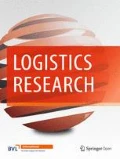Abstract
Forwarding air freight cargo globally from the shipper’s door to the door of the consignee is a complex logistic process and involves freight handling by several collaborating logistics companies. The door to door process is currently standardized by the International Air Transport Association with the industry initiative Cargo 2000. Many individuals with their own perspectives along the logistic chain decide how freight is transported and handled but have only limited insights how their decisions influence the follow-up decisions and the final on time delivery. A central planning authority can not be realized due to the heterogeneity of decision makers, the individual interests of the logistics companies, and their global operations. We argue that it is possible to overcome the deficient situation of complex transportation chains like in the air cargo industry by using optimization methods for decentralized decision making. This paper proposes a dynamic programming approach, which enables the decision makers in the decentralized situation to align their decisions better with the decisions of the involved partners. The approach guarantees that sensitive information of the logistics companies is kept local and only the most necessary information is shared along the logistic chain for a better planning. The transportation is planned with regard to multiple criteria, like the expected transportation costs and the probability to deliver the freight on time. We further show that our decentralized and multicriteria approach leads to better results compared to a local strategy that only exploits each decision maker’s own perspective. Our approach is decentralized by nature and needs lean information exchange. Furthermore, it is as strong as a centralized approach that gathers all distributed information but that authorizes the logistic service providers to decide individually.






Similar content being viewed by others
Notes
The notation 2L means the power set of the set L.
References
Abram J, Rhodes I (1982) Some shortest path algorithms with decentralized information and communication requirements. IEEE Trans Autom Control 27(3):570–582. doi:10.1109/tac.1982.1102987
Azevedo JA, Costa MEOS, Madeira JJERS, Martins EQV (1993) An algorithm for the ranking of shortest paths. Eur J Oper Res 69(1):97–106. doi:10.1016/0377-2217(93)90095-5
Bartodziej P, Derigs U, Zils M (2007) O&D revenue management in cargo airlines—a mathematical programming approach. OR Spectr 29(1):105–121. doi:10.1007/s00291-005-0019-y
Bertsekas DP, Tsitsiklis JN (1991) An analysis of stochastic shortest path problems. Math Oper Res 16(3):580–595. doi:10.1287/moor.16.3.580
Cho J, Kim H, Choi H (2010) An intermodal transport network planning algorithm using dynamic programming—a case study: from Busan to Rotterdam in intermodal freight routing. Appl Intell 1–13. doi:10.1007/s10489-010-0223-6
Cormen TH, Leiserson CE, Rivest RL, Stein C (2001) Introduction to algorithms. 2nd edn. MIT Press, Cambridge
Coutinho-Rodrigues JM, Clímaco JCN, Current JR (1999) An interactive bi-objective shortest path approach: searching for unsupported nondominated solutions. Comput Oper Res 26:789–798. doi:10.1016/s0305-0548(98)00094-x
Crainic T (2003) Handbook of transportation science. In: International Ser Oper Res Management Sci, vol 56, 2nd edn. Chap. Long Haul Freight Transportation. Springer, New York, pp 451–516
Desrochers M, Soumis F (1988) A generalized permanent labelling algorithm for the shortest path problem with time windows. IFOR 26(3):191–212
Duffie NA (2008) Challenges in design of heterarchical controls for dynamic logistic systems. In: Kreowski HJ, Scholz-Reiter B, Haasis HD (eds) Dynamics in logistics. Springer, Berlin, pp 3–24. doi:10.1007/978-3-540-76862-3
Grünert T, Sebastian HJ (2000) Planning models for long-haul operations of postal and express shipment companies. Eur J Oper Res 122(2):289–309. doi:10.1016/s0377-2217(99)00234-9
Hülsmann M, Windt K (eds) (2007) Understanding autonomous cooperation & control in logistics—the impact on management, information and communication and material flow. Springer, Berlin
Iori M, Martello S, Pretolani D (2010) An aggregate label setting policy for the multi-objective shortest path problem. Eur J Oper Res 207(3):1489–1496. doi:10.1016/j.ejor.2010.06.035
Krajewska M, Kopfer H (2009) Transportation planning in freight forwarding companies: Tabu search algorithm for the integrated operational transportation planning problem. Eur J Oper Res 197(2):741–751
Murthy I, Sarkar S (1998) Stochastic shortest path problems with piecewise-linear concave utility functions. Manag Sci 44(11):125–136. doi:10.1287/mnsc.44.11.s125
Nielsen LR, Pretolani D, Andersen KA (2009) Bicriterion shortest paths in stochastic time-dependent networks. In: Barichard V, Ehrgott M, Gandibleux X, Tkindt V (eds) Multiobjective programming and goal programming, Lecture Notes in Economics and Mathematical Systems. vol 618, Springer, Berlin, pp 57–67
Raith A, Ehrgott M (2009) A comparison of solution strategies for biobjective shortest path problems. Comput Oper Res 36:1299–1331. doi:10.1016/j.cor.2008.02.002
Reinhardt LB, Pisinger D (2011) Multi-objective and multi-constrained non-additive shortest path problems. Comput Oper Res 38:605–616. doi:10.1016/j.cor.2010.08.003
Schönberger J (2005) Operational freight carrier planning: basic concepts, optimization models and advanced memetic algorithms. 1st edn. Springer, Berlin
Tarapata Z (2007) Selected multicriteria shortest path problems: An analysis of complexity, models and adaptation of standard algorithms. Int J Appl Math Comput Sci 17:269–287. doi:10.2478/v10006-007-0023-2
Wakuta K (2001) A multi-objective shortest path problem. Math Meth Oper Res 54:445–454. doi:10.1007/s001860100169
Wu Y (2010) Modeling of containerized air cargo forwarding problems under uncertainty. J Oper Res Soc (to appear). doi:10.1057/jors.2010.84
Acknowledgments
We are indebted to two anonymous referees for their insightful comments on drafts of this paper and for pointing out additional references.
Author information
Authors and Affiliations
Corresponding author
Additional information
This research is developed within the project ADiWa funded by means of the German Federal Ministry of Education and Research under the promotional reference 01IA08006. The authors take the responsibility for the contents.
Rights and permissions
About this article
Cite this article
Berger, M., Schröder, M. Multicriteria decentralized decision making in logistic chains: a dynamic programming approach for collaborative forwarding of air cargo freight. Logist. Res. 3, 121–132 (2011). https://doi.org/10.1007/s12159-011-0055-8
Received:
Accepted:
Published:
Issue Date:
DOI: https://doi.org/10.1007/s12159-011-0055-8




